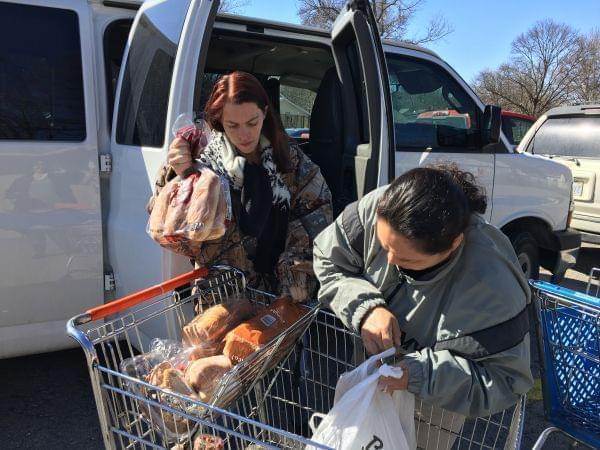Serving And Hungry: How A Federal Rule Keeps Some Military Members From Food Aid

Amy Truckowski (left) and Sandra Viloria, both U.S. Army veterans, carpooled to the Leavenworth Mission Food Pantry in March to pick up a week’s worth of groceries. The pantry is near the U.S. Army installation at Fort Leavenworth. Peggy Lowe/Harvest Public Media
The two women wheel a grocery cart across the parking lot to a white van, open the door and shove kids’ toys out of the way.
Sandra Viloria and Amy Truckowski are friends and U.S. Army veterans who carpooled to the Leavenworth Mission Food Pantry to stock up on a week’s essentials — canned vegetables, bread, eggs and frozen meat. The food pantry is just a couple miles from Fort Leavenworth, the large U.S. Army installation in northeast Kansas.
Truckowski, who served at Fort Leonard Wood, a U.S. Army base in southwest Missouri, from 2000-2002, recalled that her salary was low as a young enlisted soldier. But she made too much to qualify for the Supplemental Nutrition Assistance Program, or SNAP, the federal government’s largest food assistance effort.
Instead, she’d go to a local food bank, she said. But first, Truckowski said, she would go home and take off her uniform so she’d look like a civilian.
“It was humiliating,” she said. “I mean, you’re serving and you’ve got your children and most of the time you’ve got to take your children with you because you have no child care because that’s too expensive.”
Like Truckowski, many active-duty service members can’t get SNAP benefits because the government counts a soldier’s housing allowance as income, pushing them above the federal eligibility line.
The Department of Defense has incomplete data on hungry soldiers and their families, according to the U.S. Government Accountability Office. But it knows, for instance, that 24 percent of children in base schools in the continental U.S. were eligible for free meals in 2015.
Of those active-duty military members who are eligible for SNAP, they spent more than $55 million dollars in benefits at base commissaries in 2015, according to the U.S. Department of Agriculture.
“I just didn’t think it was right that they would both be serving their country and having to scrape by,” said Greg Douquet, a retired U.S. Marine Corps colonel who saw firsthand the struggles of those under his command.
It was especially true for lower-ranking enlisted service members with kids who live off-base, he said. A Marine Corps private, for instance, makes about $1,850 a month. And more than half of active-duty service members are married, according to the U.S. Department of Defense. Douquet said that means they struggle with the same problems other families have, such as a spouse keeping a job.
“Military families are particularly prone to such money worries just because of the nature of military service, particularly with the requirement to have to pick up and move every couple, three years,” Douquet said.
What’s more, the housing allowance is based on the cost of living in any given location, so it can rise in high-priced areas, disqualifying some active-duty service members from SNAP.

Iris Arnold founded and operates the Leavenworth Mission Food Pantry near Fort Leavenworth in northeast Kansas. She used to be open just once a month, but because of long lines and high demand, she’s now open every Tuesday.
In 2016, U.S. Rep. Susan Davis, a California Democrat, introduced the Military Hunger Prevention Act, which would have removed the basic housing allowance from a service member’s income when qualifying them for SNAP.
Ultimately, House Agriculture Chairman Mike Conaway, a Texas Republican, put the plan in this year’s farm bill —with a substantial change. The first $500 of a monthly housing allowance would be exempted, he said, calling it a first step, considering there’s no extra money available for the massive piece of legislation.
“It’s 500 bucks a month on housing that does not count against you, which previously did, and so we think that that it begins to address that issue,” Conaway said during a recent conference call with reporters.
Anti-hunger advocates say they are disappointed with Conaway’s plan. Josh Protas, vice president of public policy at Mazon, a Jewish Response to Hunger, said he sees Conaway’s effort as a “partial fix.”
“We’ve been very disappointed that we can’t get a full fix for this and make sure that those who are serving our country honorably can get the help that they need and deserve,” said Protas, who supported Davis’ bill.
Protas said he and other advocates are hoping the Senate’s version of the farm bill hews more closely to Davis’ idea or perhaps even Davis’ bill will be revived (it has 66 co-sponsors, from both sides of the aisle). Advocates also may try to get it included in the National Defense Authorization Act, the big defense appropriation bill, he said.
Through their own field work, coupled with information from the Pentagon, Protas said Mazon discovered that there are food pantries near most military bases in the U.S.
That doesn’t surprise Iris Arnold, who founded and runs the Leavenworth Mission Food Pantry. It used to open once a month, Arnold said, but they saw long lines and high demand.
“When we were open once a month, 187 people (were served) last time we were open, in a three-hour time span,” she said. “After then, we’re just wiped out.”
Now, she’s open every Tuesday, one of 14 food pantries in Leavenworth, a city of 36,000.
This story is one of Harvest Public Media’s five-part series on the federal Supplemental Nutrition Assistance Program. Peggy Lowe is a contributor to Harvest Public Media and is based at KCUR in Kansas City. Follow Peggy on Twitter: @peggylowe
Links
- Fearing Deportation, Unauthorized Immigrants Shy Away From Signing Kids Up For Federal Food Aid
- Food, Agriculture And Politics In The Next Farm Bill; Evangelicalism In The Age of Trump
- Federal Food Aid Program Difficult To Navigate, But Crucial Service For Mentally Ill
- Expanding Work Requirements For Food Assistance At Center Of Farm Bill Debate
- Obtaining Federal Food Aid Takes Time, Patience
- Changes To Federal Food Assistance, Conservation Programs In First Public Farm Bill Draft
- Farm, Food, Forestry And More On The Table In The Next Federal Farm Bill

